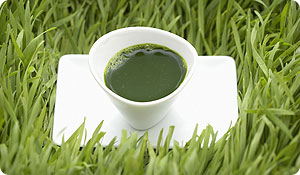
Wheatgrass is sold as a juice, a pill, a powder and, in some greenmarkets and natural foods stores, a potted plant. Touted as a "living food," wheatgrass juice first became popular in the 1950's, when a self-proclaimed "natural healer" began to promote the benefits of consuming green vegetables, herbs, and wild weeds. Since then, wheatgrass has been analyzed, studied, and sold as a health remedy.
In fact, wheatgrass does contain important nutrients and enzymes—the same ones found in many raw fruits and vegetables. But since wheatgrass only contains very small quantities of most of these nutrients, it is most often served as a juice or concentrated in supplement form. Even so, the promotional materials and claims regarding extracts of this very green grass tend to focus more on its high chlorophyll content than its supply of vitamins and minerals.
Chlorophyll is a pigment that gives green plants their color, just as hemoglobin gives red blood cells their color. Chlorophyll also plays a similar role in plants that hemoglobin plays in humans. Through the process of photosynthesis, chlorophyll helps the plant capture sunlight, which, along with carbon dioxide and water, creates and distributes nutrients that provide the plant with energy. In humans, blood carries oxygen-rich hemoglobin and other nutrients from food through the body and metabolizes them for energy. But while chlorophyll has much in common with blood, it is not interchangeable, and your body has no more need for chlorophyll than your spider plant has for red blood cells.
At the same time, chlorophyll is not toxic to humans, and wheatgrass can be considered as much a source of nutrients as many other vegetables if you consume enough of it. If you enjoy the leafy, somewhat bitter flavor of wheatgrass juice, drink up! But if not, there is no reason to feel you are missing out on an important source of nutrients. If you are a healthy person and you eat green vegetables on a regular basis, you are certainly getting everything wheatgrass has to offer in the way of health benefits, and maybe more.
But wheatgrass juice may confer health benefits to a select group of people. One small Israeli study published in the Scandinavian Journal of Gastroenterology found wheatgrass juice to be effective at treating symptoms of ulcerative colitis without causing any side effects. If you suffer from colitis, ask your health care provider if wheatgrass can help. But to date, colitis is the only condition associated with any benefits from wheatgrass. There is no evidence that wheatgrass or its extracts have any effect on cancer, arthritis, fatigue, or other medical conditions listed on web sites or in other materials used to sell wheatgrass products.
Sources:
Ben-Arye E, et al. "Wheat Grass Juice in the Treatment of Active Distal Ulcerative Colitis." Scandinavian Journal of Gastroenterology. 2002 Apr; 37(4):444-9. Web. 12 Aug 2011
http://www.ncbi.nlm.nih.gov/pubmed/11989836
Higden, J. "Chlorophyll and Chlorophyllin." Oregon State University Linus Pauling Institute, 2005, updated 2009 Web. 12 Aug 2011
http://lpi.oregonstate.edu/infocenter/phytochemicals/chlorophylls/
Simonich, MT. "Cancer Prevention by Chlorophylls." Oregon State University Linus Pauling Institute Research Newsletter, 2006 Web 12 Aug 2011
http://lpi.oregonstate.edu/fw06/chlorophylls.html





